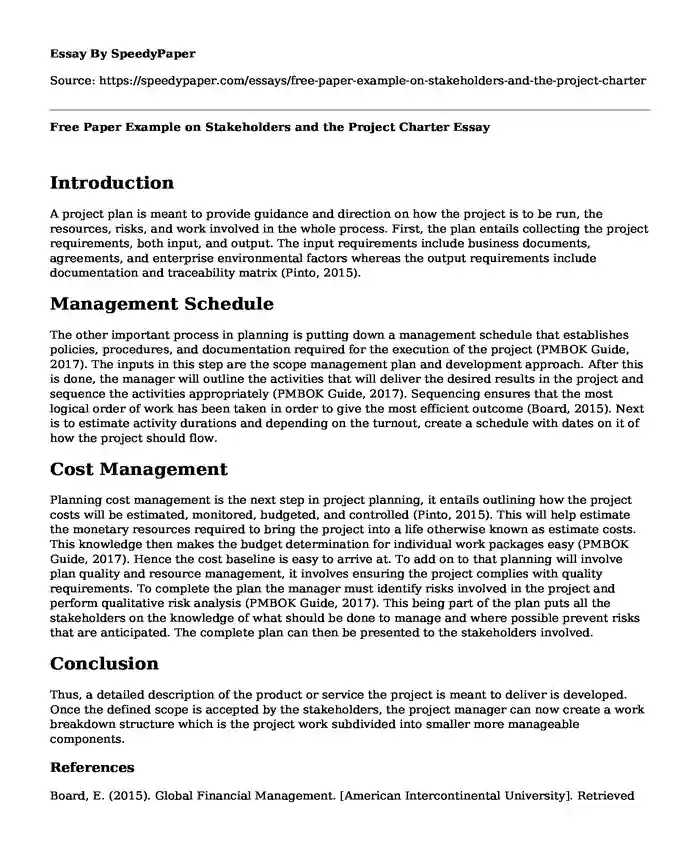
| Type of paper: | Essay |
| Categories: | Project management Finance Business |
| Pages: | 2 |
| Wordcount: | 439 words |
Introduction
A project plan is meant to provide guidance and direction on how the project is to be run, the resources, risks, and work involved in the whole process. First, the plan entails collecting the project requirements, both input, and output. The input requirements include business documents, agreements, and enterprise environmental factors whereas the output requirements include documentation and traceability matrix (Pinto, 2015).
Management Schedule
The other important process in planning is putting down a management schedule that establishes policies, procedures, and documentation required for the execution of the project (PMBOK Guide, 2017). The inputs in this step are the scope management plan and development approach. After this is done, the manager will outline the activities that will deliver the desired results in the project and sequence the activities appropriately (PMBOK Guide, 2017). Sequencing ensures that the most logical order of work has been taken in order to give the most efficient outcome (Board, 2015). Next is to estimate activity durations and depending on the turnout, create a schedule with dates on it of how the project should flow.
Cost Management
Planning cost management is the next step in project planning, it entails outlining how the project costs will be estimated, monitored, budgeted, and controlled (Pinto, 2015). This will help estimate the monetary resources required to bring the project into a life otherwise known as estimate costs. This knowledge then makes the budget determination for individual work packages easy (PMBOK Guide, 2017). Hence the cost baseline is easy to arrive at. To add on to that planning will involve plan quality and resource management, it involves ensuring the project complies with quality requirements. To complete the plan the manager must identify risks involved in the project and perform qualitative risk analysis (PMBOK Guide, 2017). This being part of the plan puts all the stakeholders on the knowledge of what should be done to manage and where possible prevent risks that are anticipated. The complete plan can then be presented to the stakeholders involved.
Conclusion
Thus, a detailed description of the product or service the project is meant to deliver is developed. Once the defined scope is accepted by the stakeholders, the project manager can now create a work breakdown structure which is the project work subdivided into smaller more manageable components.
References
Board, E. (2015). Global Financial Management. [American Intercontinental University]. Retrieved from
https://aiu.vitalsource.com/#/books/9781943926008/
Pinto, J. K. (2015). Project Management. [American Intercontinental University]. Retrieved from
https://aiu.vitalsource.com/#/books/9780133798241/
PMBOK Guide (2017). A Guide to the Project Management Body of Knowledge (PMBOK® Guide)–Sixth Edition. [American Intercontinental University]. Retrieved from
https://aiu.vitalsource.com/#/books/9781628253900/
Cite this page
Free Paper Example on Stakeholders and the Project Charter. (2023, Nov 02). Retrieved from https://speedypaper.com/essays/free-paper-example-on-stakeholders-and-the-project-charter
Request Removal
If you are the original author of this essay and no longer wish to have it published on the SpeedyPaper website, please click below to request its removal:
- The Bike Riding Startup - Business Plan Essay Sample
- Essay Example on Business Law and Ethics
- Essay Sample about Business Ethics and the Corporate Social Responsibility
- Free Paper on ERP SAP Implementation in Logistics and Supply Chains
- Free Essay. Southwest Airlines' Strategic Approach to Human Resource Management
- Free Essay. Gap or Opportunity Identification
- FASB Proposal - Free Essay Example
Popular categories




